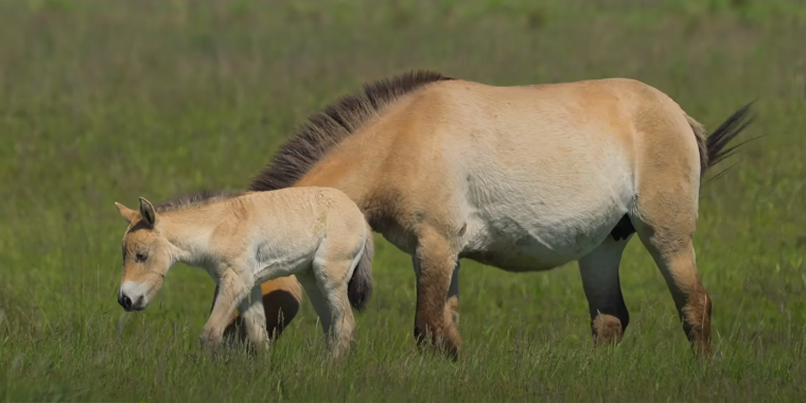Artificial intelligence (AI) is helping to save endangered Asian wild horses, which one may be familiar with from prehistoric cave paintings, on the Hortobágy National Park. Students and researchers from Debrecen University are observing the behaviour of Przewalski horse herds with drones, whose high-resolution footage is processed by Microsoft Azure and analysed by AI, which distinguishes the horses from other animals, like the cattle also present in the area. Artificial Intelligence is tackling a formerly months-long workload within just a few minutes, and from a distance so without disturbing the animals.
Hungary is home to several endangered species like the Great Bustard (Otis tarda), which many of us are familiar with, as it is displayed within the logo of the Hungarian Ornithological and Nature Conservation Association. What is not that well known is that Hungary hosts the world’s largest wild horse population within semi-wild conditions. About 300 protected Przewalski horses, of which there are only 2000 across the globe, graze in the biosphere reserve of the Hortobágy National Park, which is closed to visitors. Centuries before, those horses galloped across the steppes of Asia, mostly in the territory of today’s China, Kazakhstan, and Mongolia, but bones originating from Przewalski horses have also been excavated in France. Nomad tribes however, mercilessly exterminated this species and so their last wild specimens were seen in 1968 in Asia.
Today, they are being reintroduced to their original habitat Mongolia from Hungary, thanks to a many-year long and especially successful breeding program. A mere 22 specimens arrived to Hungary in 1997-2001 to establish the herd, but today around 30 harem groups of varying size are kept track of and they appear to be outgrowing the 3,000-hectare nature reserve territory. Today, AI is playing a major role in this success story, which Microsoft has been facilitating for the project’s conservationists and researchers.
Microsoft joined forces with the Hortobágy National Park, the University of Debrecen, Faculty of Science and Technology, and the Department of Evolutionary Zoology, three years ago, in 2018, to save the rare, wild horses. One of Hungary’s Artificial Intelligence Knowledge Centres was stablished at the University of Debrecen, where the latest technology and proper software are combined to help students and their mentors implement outstanding research projects. Due to AI Knowledge Centres’ activities, digitalisation is being introduced into Hungarian higher education, providing the next generation with even more competitive skills in most scientific fields.
To study the horses’ behavioural ecology, researchers have been utilising drones above the territory of the national park, which have allowed them to observe vast areas without disturbing the animals. High resolution drone footage of herds which can be zoomed in and out of and slowed down is analysed by artificial intelligence provided by Microsoft. It can distinguish horses from cattle and aurochs also present in the area. Today, the technology is being developed to be able to identify each individual horse, despite its being very similar to others based on coloration or other characteristics. This work would take months if it were done by the students themselves, while unintentionally influencing the behaviour of the horses and thus the research itself. With AI, horses and cattle can be distinguished from each other within minutes or in the real-time displayed in video while watching it, allowing for observation of behaviour in the natural habitat from a distance. An enormous amount of data is processed by Microsoft Azure, which provides the necessary computing capacity, so that 4K video and the results of the analysis can be run simultaneously on multiple computers.
Having acquired this wealth of experience and research data, experts from Debrecen University can advise their fellow researchers working in other countries on the reintroduction of Przewalski horses. What’s more, this infrastructure backed by Microsoft technology is also set to be applied in Mongolia, on territories spanning at least a million hectares.
“We’re saving a lot of time with artificial intelligence, and we can do our job much more efficiently,” said Viola Kerekes, project coordinator at the Hortobágy National Park. “Conservationists are especially fond of this new technology because it helps us reintroduce a species into its native, natural habitat where it had gone extinct.”
“This project is important, not just because it helps save an endangered species but also because it allows us to demonstrate that the conservationist community, and that of artificial intelligence users and developers, can work together in Hungary. Their cooperation can create new value, further enhancing environmental protection” said Dr. Zoltán Barta, professor at the Faculty of Science and Technology, University of Debrecen.
Besides the University of Debrecen’s AI Knowledge Centre, there are AI Knowledge Centres currently operating at the Budapest University of Economics, the University of Pécs and at five other universities, where various scientific projects are being implemented with the support of the latest technology.
A sztorit magyar nyelven ezen a linken olvashatja el.

